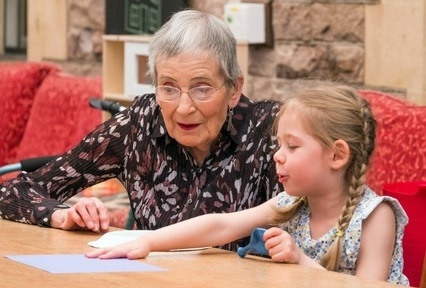This week, I’ve watched this program on Channel 4. It received great reviews on social media and in the press. It enthralled all my family and was genuinely heart-warming watching the transformation of 11 frail residents in an old people’s home. The older people were first assessed physically and mentally and were typically losing their mobility with a bleak outlook and little purpose in “God’s waiting room” as one resident put it; suffering from social isolation and depression is how Prof Malcolm Johnson described it. After six weeks of activities with 10 four-year-olds they were reassessed with 70% improving their mood and 80% improving physical abilities. Many of the social media comments I’ve seen demanded that the nation just got on with rolling this out nationally – how hard can it be?
To me it seemed the success of the experiment had several factors:
- Vision and Planning – the activities were carefully structured over the 6-week period to become more physically demanding. Doubtless safeguarding was a key part of planning.
- Expert staff – the nursery staff were expert at including everyone in the activities, young and old.
- Fun and feedback – the joy of the experiment was palpable; although the participants already knew that they felt better in themselves, they were interested to find out their improved scores in the tests and positive feedback boosted them.
- Great facilities – there was a dedicated space for the participants to use indoors and beautiful gardens outdoors. There were sufficient staff to keep everything ticking along and safe, for example when one child ran ahead of the person she was walking with in the gardens.
- Selection – the experiment involved a small number of the residents from a large community and 10 pre-schoolers. Apart from being happy to appear on TV, how were they selected and how important was that to the overall success?
The wonder of this experiment is that the whole is greater than the sum of the parts. Pre-schoolers need supervision and so do older people in care homes; by bringing the two generations together the benefits are magnified for both groups. The focus was on the older people but it was clear that the children also benefitted from their new friendships. The improvement wasn’t brought about by a lavish new scheme, but using what is there already with a little seedcorn and lots of vision. Some care homes may not have the beautiful grounds used for outdoor activities, but transport can be arranged to a park for the same effect.
One of the residents, Hamish, commented that he didn’t know if the improvements in mood were due to the sunshine or the children. Although there was no control group in the experiment, with a bit of searching I found this recent research on the NICE pages, Evaluation of the Reducing Social Isolation and Loneliness grant fund : evaluation final report which tells us…
[some organisations]… engaged with schools to deliver intergenerational activities with their users, with positive results. When engaging schools it is important to allow time for building relationships. The start-up work can be slow; it can be difficult to identify the right contact at the school, there are bureaucratic processes to work through, and teachers are extremely busy.
Anecdotally, primary schools are reported to be more accessible and flexible compared to secondary schools. The timing within the academic year may also be critical to securing successful engagement, with the autumn term being seen as particularly busy in schools.
Another report identifies several success factors for intergenerational projects, including ensuring that there are mutual benefits from activities that are appropriate to both generations. What I could not find is evidence that this type of intervention is better that other activities. If anyone can point me to some, please add a comment below. This is an important point, since while we all want older people to thrive, it would be worth comparing the benefits of this type of activity with other well-run activities such as exercise classes, a community choir or art lessons. I’m sure all of those will work for some people.
Other reports describe a range of intergenerational activities with the focus on sharing skills from cooking to crafts and the internet. These activities often involve people living at home as well as those in residential care. In my own community, older independent people are involved in a mums and toddlers group and helping refugees learn English. For intergenerationality to work outside residential care, older people need to be assured that they have useful skills and contributions to make, and be made welcome as volunteers in our schools and other groups, eg to read to/listen to the reading of primary age children. I think to make this happen the missing connection for wider intergenerational activities is the selection process: the identification & organisation of activities that can involve older people mixing with younger ones and the brokerage or linking of individuals to particular projects that interest them.
So the big message from this programme is that social isolation devastates people’s wellbeing and the elderly are particularly vulnerable. It is not cured by a pill but by people, people who spend time and show interest. The people don’t have to be specialists, even children can do it, but they do need to be working within well-structured and delivered activities that are of interest to them and help preserve the purpose of the older people and safeguard young and old alike. The keys to success are well understood but not trivial, the programme has given us the vision, I look forward to seeing more intergenerational activities to combat social isolation for all, not just those in care homes.
—
Photo credit: Channel 4.
